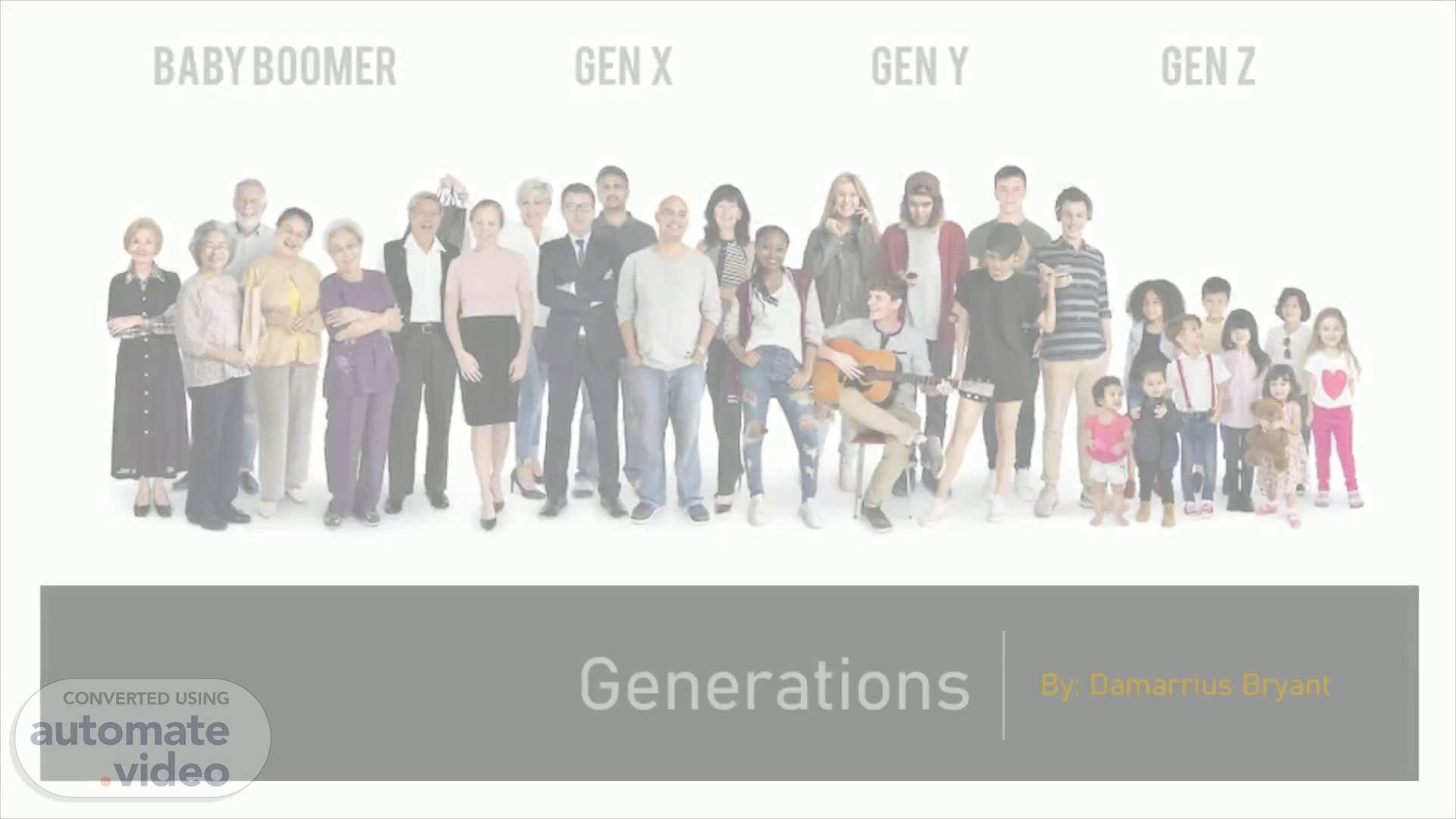Scene 1 (0s)
[Audio] Hello and Welcome to, Generations By Damarrius Bryant.
Scene 2 (7s)
[Audio] Generations refer to all of the people born and living collectively at about the same time..
Scene 3 (19s)
[Audio] Overview. Overview.
Scene 4 (23s)
[Audio] Issues. With each generation having such distinctive traits and characteristics, there is a potential risk of conflicts occurring due to clashing values and beliefs, work ethics, and communication styles. Interpersonal issues are often one of the biggest problems that employers face when dealing with generational diversity.
Scene 5 (45s)
[Audio] Trends. The way each generation defines, and approaches diversity differs. With diversity increasing in each generation this is to be expected. It gets increasingly more accepting as the years go on as different cultures and values are passed down and spread out..
Scene 6 (1m 6s)
[Audio] Statistical data. I asked 2 members from generations X-Z respectively, and along with data from other research I have concluded the following; Gen X: They look at it from more of an old point of view. Describing it as " Race and gender". Gen Y: They have a more open and growing description of diversity. One changing and correcting the other during the interview. Their final description being " Age, race, gender, and sexuality". Gen Z: They were the quickest to answer and the most thoughtful with their answer, " Id say its more than just race and gender." Followed by the other saying "Yeah its like different pov's ( points of views) coming together and getting along"..
Scene 7 (1m 52s)
[Audio] Two implications of the state, national and world demographics that pertain to Generations. 1.) Nearly 100 Confederate Monuments Removed In 2020, Report Says; More Than 700 Remain - As we become more diverse, we understand each other's pains and struggles. The removal of these monuments shows a culture shift were talking as a nation. 2.) Distribution of the race and ethnicity of the United States population in 2018, by generation - Diversity is increasing more and more by the generations. As shown on the graph..
Scene 8 (2m 33s)
[Audio] The effects of diversity on a state's economy and people - Danor Gerald. Press play and watch the video. As you are watching One point I would like to highlight is around 2: 40 where he talks about how stereotypes can cost a community's reputation. This is an important thing to remember when talking about other cultures because it may not always be true or helpful to said culture..
Scene 9 (7m 33s)
[Audio] Barriers in diversity among the generations.
Scene 10 (7m 41s)
[Audio] Communication Styles. Whether it be technology or face to face communication with all these generations together we are bound to hit a roadblock. The older generations will most likely prefer face to face over text and emails. The middle generation may be more willing to use email and texts but are still accustomed to face to face. And lastly the youngest generation are much more accustomed to a more tech orientated communications than in person. Gen X: A study from systems integration firm NTT Data confirmed that email is this generation's preferred form of communication, whether at work or in the comforts of home. According to an article from Getting Smart, Generation X prefers receiving and using short, brief messages as opposed to lengthy ones. Gen Y: A study of millennials by BankMyCell found most respondents didn't answer phone calls because it was "time consuming." A survey by management consulting firm Korn Ferry found that millennials also often avoid face-to-face interactions, instead preferring to use online messaging software ( 55 percent) or e-mail ( 28 percent) to communicate with bosses or co-workers. So, the best way to communicate with millennial employees is reaching them through digital messaging apps. Gen Z: 65 percent of Generation Z prefer to communicate online more often than in person, according to a study by cloud mobile solutions company LivePerson. In addition, research suggests that growing up with lightning-fast internet and upload speeds may have impacted their preferences on speed in communication, as well. A survey by marketing company LeadSquared reported Generation Z expects rapid responses from whoever they're sending a message..
Scene 11 (9m 39s)
[Audio] Clashing Values. A lack of mutual understanding makes it challenging for team members from different generations to communicate and collaborate effectively. Each generation are so distinct, stereotyping can be a significant issue that causes a divide among employees. Different perspectives can also lead to clashing values. Being from different generations and cultures makes us see things in a particular way often leading us to not see each others' points of view..
Scene 12 (10m 11s)
[Audio] How has the media had an impact (negative or positive) on your topic/ group? The media has had a more positive impact on the impact of diversity and inclusion on the different generations. It allow issues and topics of diversity and inclusion be more accessible and public. We can now discuss these topics and reach a conclusion..
Scene 13 (10m 36s)
[Audio] Why did I choose this particular topic? Being a little late to choose a topic, I had to choose between this one and another. But in the end, I think generations spoke more to me than the other. And I've learned a lot on my journey to complete it..
Scene 14 (10m 55s)
[Audio] The End… Well, this is the end of my presentation on the impact of diversity and inclusion on the different generations. It's been a very eye-opening experience for me. I feel like I've become more conscious as a result of it. From watching out for stereotypes that fly under the radar to thinking about how I communicate with others, I will definitely take some of this information to heart. Thank you for reading..
Scene 15 (11m 24s)
[Audio] This is just the reference page.. Reference Page..
